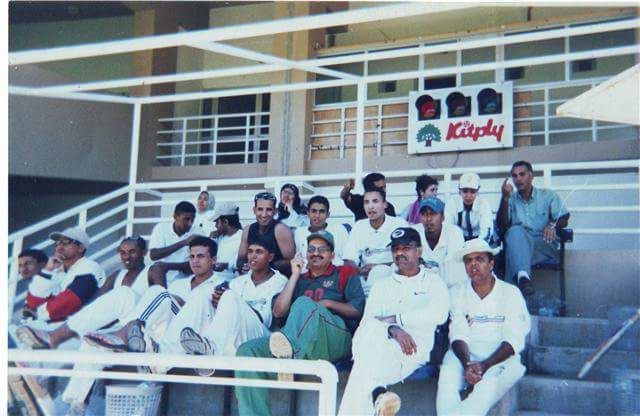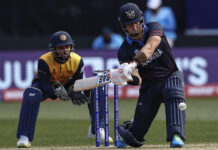Morocco hasn’t been kicked out of the ICC because Moroccans don’t play cricket. Or because the North African Kingdom hasn’t got the facilities. Morocco has been kicked out because of woeful management that forced the ICC to act.
“I’m very very sad and not surprised at the same time because we have poor management,” fumes Mohammed Ennaoui from Casablanca.
Two decades ago, Ennaoui was playing football on scrubland in his home city with his brother Abdelghani and a bunch of other Moroccans.
On the other side of the field were a group of immigrants playing a strange game with a wooden stick. “We were just a bunch of Indians playing tennis ball cricket,” recalls Kishor Kirpalani, who loved cricket and watched it avidly on satellite television.
Both Kirpalani and Mohammed Ennaoui would go on to be coached by a World Cup winners, play with an Australian Test great and captain their country in ICC competitions. Abdul Rahman Bukhatir changed all that.

The story of how the game boomed then imploded in Morocco cricket is one of baksheesh, bombs, millions of dollars of investment and the death of a dream.
Bukhatir developed a love for cricket after visits to Lords with a group of fellow Emiratis in the 1980s. He built a castle in his native Sharjah and created the Cricketers’ Benefit Fund series, which attracted the biggest stars with hefty payments for matches beamed back to Asia.
To help publicise the matches, Bukhatir invited Bollywood film stars, who brought their backers and hangers-on. One of whom, Dawood Ibrahim, had a box at Sharjah, where he could be seen drinking lemon tea and smoking for games between India and Pakistan.
That was never going to end well because Ibrahim runs the Indian organised crime syndicate, D-Company and controls much of the company’s illegal gambling.
At one point, Kapil Dev recalls Ibrahim entering the changing room before an India international at a ground where allegations of fixing swarmed like desert flies.
When two investigations, the Qayyum and Condon inquiries, fingered Sharjah as a hub of fixing, Bukhatir knew he needed to find a new venue but he already had one in mind.
In 1991, a Moroccan called Mohammed Larbi Tabla had formed his country’s first cricket club. They practiced in the grounds of the Hilton Hotel. One day, a mysterious stranger wearing robes stopped to watch and asked one of the Moroccans, Mohammed Drissi, about the game in Morocco.
“They had no equipment”, said Drissi. Bukhatir promised to help and so Moroccan cricket found a benefactor.
Bukhatir went hunting in Morocco, did business there and decided to build a sports complex at the former Tangier golf club, which cost $28m and included a $4m cricket stadium.
Phil Simmons brought a side out to Tangier and the former West Indies Test player was impressed. “It’s flat, it’s hard, it moves around and offers a bit to both batsmen and bowlers,” Simmons told The Times.
“It’s amazing to play first-class cricket here in North Africa. I can see this as a big venue for the future.. The weather’s terrific and it’s just over a two-hour flight from London. The potential is enormous. Apart from the prospect of staging international tournaments here, it could be a fantastic training facility for English counties.”
Offering prize money of $250,000, Bukhatir managed to persuade Pakistan, South Africa and Sri Lanka to come to Tangier. In 2002, Morocco saw stars such as Allan Donald, Shaun Pollock, Waqar Younis and Sanath Jayasuriya playing, in a country with virtually no cricket history.

The shadow of Ibrahim lurked and CCTV was fitted to prevent any approaches. Match referee Mike Procter gave the ground the go-ahead and Sri Lanka went on to win.
In a country with no cricketing culture, crowds were small but Bukhatir was there and amongst the hundreds in the stands were Kirpalani and the Ennaouis.
Bukhatir had sent out his emissaries looking for members of Morocco’s Indian community who played cricket. Finding Kirpalani, he sent them equipment and then a very illustrious pair of coaches.
“The day that we met him, Mr Bukhatir promised that after two weeks he would send us the whole kit and also Mohinder Amarnath and Surinder Amarnath,” marvels Kirpalani.
Mohinder ‘Jimmy’ Amarnath was player of the match when India won the World Cup in 1983 and a regular in Sharjah. Recruited by Bukhatir, he arrived in Morocco in 2000 with his brother to develop the game in North Africa.
“Equipment came from Sharjah but they had no idea of how to play the game and sometimes they would come to practice, sometimes they would not,” recalls Amarnath. “There were not many places to play and no cricket grounds. We played at football stadiums and for the games, they just put coir matting on a normal surface.”
A federation had been formed in 1999 and was given the King’s blessing in 2001, when the number of clubs had grown to eight and a championship was contested annually.
In early 2002, Chakib Neijar, a prominent chemist in Rabat, eagerly took up the role of president of the Royal Moroccan Cricket Federation for the next five years. Neijar kept referring to runs as points.
Enthusiastic cricketers like Kirpalani and the Ennaouis initially shrugged off these idiosyncrasies. A sport they loved was taking off and attracting more indigenous Moroccans like a teenage postman from Casablanca called Zaki Zakaria.
“When I tried this game, I just loved it. This is a game for gods and for angels,” says Zakaria, whose career would mirror the rise and fall of Moroccan cricket.
Bukhatir tried to get another tri-series staged in Tangier with West Indies, New Zealand and Australia but suicide attacks in Casablanca that killed 45 people suddenly made Morocco less attractive. Australia pulled out. Although the MCC came to Tangier in 2004, the Morocco Cup was never staged again.
The Amanarths went back to India and were replaced as head coach by former Australia test opener Gary Cozier. Under Cozier, Morocco began playing internationals against the likes of France and Gibraltar and in 2006 entered an ICC competition in South Africa.
Opener Mohammed Soussi recalls: “Before, the Amarnath brothers showed us the basics but with Gary taught us more complicated things like how to move the ball when we bowled. When Gary first came we were good players but he then taught us another way to play cricket, the ‘Australian way’, how to be aggressive in the field, the inswing and the outswing. He taught us the professionalism of cricket, more tactics. We went on to play better teams later, but we were stronger.”
To the surprise of many, Morocco won their opening game against Rwanda, then beat Lesotho and Rwanda again to finish fifth. Their only defeats had been against the two finalists, Mozambique and Sierra Leone.
“You could see the other teams looking at us and thinking ‘who are these guys from Morocco?’, but we showed them we could play,” says Kirpalani, who was Morocco’s captain.
Despite the end of first class cricket in Morocco, the country was being swept along by Bukhatir’s largesse and Ali Bacher’s development programme. Cozier recalls players sleeping on gym floors simply so they could come to training. The game was booming with around 600 players of all ages and sexes but this investment by the players was not returned by the federation.
“I was constantly in ‘discussions’ with club officials about the annual funding arrangement and the supply of cricket equipment, which was a part of the agreement,” says Cozier.
He was supposed to be in charge, but was kept away from the purse strings from the outset despite Bukhatir – rather than the ICC – remaining the sole source of funding. Cozier adds: “We gave them $100k per year as part of the sponsorship deal. I was supposed to be the CEO for the Federation but they wouldn’t let me take any position. I went to ICC meetings, funding never came up. Bukhatir also never mentioned it.”
Eventually, Bukhatir’s patience snapped. The Tangier Oval was off limits to the Moroccans and he then stopped the payments. Dispirited by the federation, Cozier went back to Australia for family reasons in 2007.
The sclerotic federation began to fall apart. Morocco got to the Gambia for the North West Africa Championships in 2007 but withdrew from the ICC’s 2008 World Cricket League tournament.
In 2009, Division Three Africa of the World Cricket League was due to be staged in Malawi. Morocco entered and, with the ICC paying for the flights, had to fly via Qatar. In transit in Doha, the incredulous players discovered that the federation had not arranged visas to Malawi in advance.
So they flew back to Casablanca.
Back home, the players were now barred by an increasingly disenchanted Bukhatir from the Tangier Oval but still had access to another purpose-built ground built by the Emirati in Sale outside Rabat. The country was also attracting cricketing tourists such as the Brisbane-based Ned Flanders XI, Catalunya CC from Spain and Sinsen from Norway.

In 2011, Morocco played in Division Three of the ICC Africa League and won two out of four games but the federation contact with the ICC was now sporadic at best and funding for kit was sparse.
When Morocco entered what would be their last international tournament at Benoni in South Africa in 2012, Zaki Zakaria was reduced to going round to the changing rooms of Morocco’s opponents after games to try and buy their official equipment.
Haggling for second hand kit was demeaning for the Moroccans, but they had little choice as the equipment supplied by Bukhatir was falling apart.
South African Riaz Richards was recruited as national coach on a three-month contract. “There was a net in Rabat by the prison. Well, it was a net once, but not when I got there. When I saw that net, I said is that it?” recalls Richards, who found access to the field at Sale was often restricted by footballers.
He adds: “They were just a bunch of guys having a kickaround and we were a national team but we just had to wait.”
In Benoni, Morocco won twice and though momentum had been lost and undermined the playing base, Richards could still see the potential.

Now head coach at Berkhamsted CC in England, he says: “They could have been among the top 10 countries in Africa quite quickly. Zaki was the best but they had 25 players who could play at a decent club standard in England and another 25 who could also play, but the administrators were not really in it for developing the game.”
Richards was keen to stay, despite not being paid until the day he flew home but after 2012, the game in Morocco spiralled into a factious mess.
Neijar had been replaced as president by a relation of the same name and the leading players and the federation were increasingly at odds. Players wanted to know where the money went. So did the ICC.
When no answers appeared, the ICC suspended Morocco in 2015. The following year, Neijar’s term as president elapsed but attempts to hold elections were neutered by the Moroccan government, who was also taking an interest.
Amidst all this politicking, the game of cricket in Morocco simply stopped.
The Moroccan government had stepped in with funding of up to $90,000 a year after Bukhatir closed his purse strings. In February 2018, government auditors were dispatched to the cricket federation’s offices only to find the federation had vanished.
ICC Africa’s attempts to contact the Moroccan’s were not helped by emailing former members of staff, who had no interest in explaining about their involvement in the painful, gradual death of cricket in Morocco.
In November 2018, an English village cricket side, Burley, visited for two matches. Morocco played in a kit donated to them by the Norwegian side Sinsen, who had been their last visitors five years earlier.

Drawing in players from Tangier, Rabat and Casablanca, Morocco put out a development side captained by Kirpalani for one game then the national team for a second game featuring Zakaria and the Ennaouis, winning both games.
After much haggling, the games were played at the Sale Oval. Bukhatir had sold the ground to the Ministry of Forests, which wants to rip up the concrete strip. In March this year, another British side, the Traditional Corsairs visited for two games but had to play in a football stadium in Casablanca.
Earlier this year, the Moroccan government eventually agreed to form a new federation but dragged their heels for so long that in July the ICC lost patience and kicked them out.
Morocco joined the likes of Cuba, Switzerland, Tonga and the USA in being expelled by the ICC.
Unlike those other countries, cricket in Morocco had staged a first class international series featuring some of the game’s biggest names. Millions of dollars had also been invested in the game in Morocco. In return, indigenous Moroccans had begun to embrace the game only to be betrayed by their administrators.
Bukhatir still visits Morocco but has lost interest in a game he did so much to help develop. Today, the Tangier Oval is derelict and the Sale Oval is in dire need of repair.
“Cricket is over now in Morocco,” sighs a dejected Kishor Kirpalani. Along with the likes of the Ennaouis, Zaki Zakaria and Mohamed Soussi, he still loves cricket but holds out little hope for the future now the ICC has cut the Moroccans loose.
DISCLOSURE: The author is a journalist and a member of Burley CC.
Steve has previously written on global cricket for Play the Game and also reported for the BBC about Moroccan cricket.








Hope some improvement comes in Morocco cricket and it again rises again and even be full members of ICC.
Hope I see Morocco cricket becoming big and powerful.
Love from India